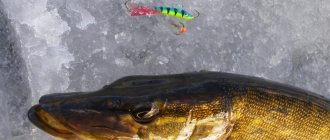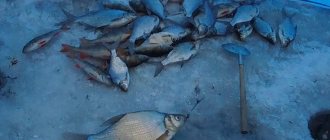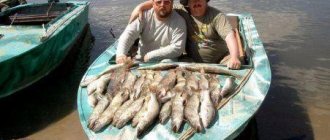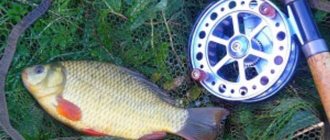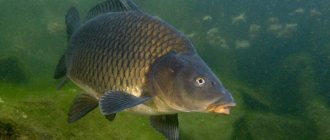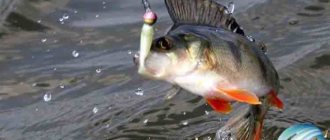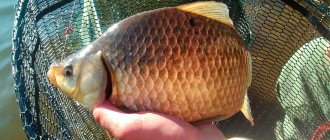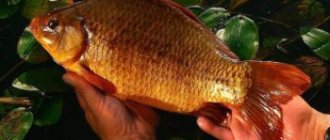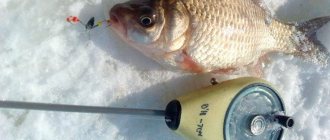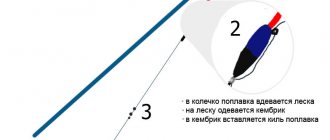For many fishermen, it may come as a complete surprise that crucian carp are successfully caught from the ice in winter. Of course, not every body of water can boast of such an opportunity. The structural features of the pond and weather conditions play an important role in the activity of fish. But experienced winter fishermen will probably tell you about a couple of reservoirs where catching fish in winter becomes commonplace, and sometimes the goal of ice fishing. Consequently, opportunities for interesting fishing strategies arise, and the presented article will reveal the secrets of catching crucian carp in winter for the angler who is interested in the question.
When is crucian carp most active?
There is an opinion that in winter crucian carp hibernate, lying on the bottom in silt deposits and mud. In fact, heat-loving fish behave differently. Crucian carp falls into a kind of suspended animation and instantly emerges from this sleepy state under favorable weather conditions. Ichthyologists believe that the activity of this heat-loving fish depends on two factors: the presence of a predator in the reservoir and mild winter weather conditions. The pike living in the pond in sufficient numbers does not allow the crucian carp to doze off . A warm winter also contributes to the continuation of fish feeding, the activity of which is comparable to the autumn period of the year already in the cooled water.
A good bite is noted when catching crucian carp on the first ice in November and December, at the very beginning of freeze-up.
Not much different in intensity, the fish bite towards the end of winter. When prolonged thaws are already observed with an influx of melted, oxygen-rich water into the holes. In the dead of winter, which falls in January, especially if there are bitter frosts and the ice is covered with a thick layer of snow, the fish become inactive and stop feeding. During this period of freezing, the bite stops and it becomes impossible to catch crucian carp.
Pike in the reservoir and the thaw affect the activity of crucian carp
Crucian carp can withstand oxygen deprivation and intense heat during the summer season, sometimes even without stopping to feed. But severe, prolonged frosts that freeze shallow reservoirs to the bottom bring catastrophic consequences. The pond's crucian carp population may disappear. Schools of crucian carp do not travel long distances in winter in search of wintering sites. The fish remain in their habitable places, flocking into large schools in the deeper parts of the reservoir.
Jig for crucian carp
The choice of jig is of no small importance. This can be done after several casts. Moreover, the color and shape of the jig may be different, depending on the nature of the reservoir. If on one body of water a crucian carp bites on a black jig, then on another it may be a completely different color or the crucian carp will refuse to bite at all.
Winter fishing for crucian carp is a lottery, because it is very rarely possible to find the key to this fish. The same can be said about other types of fish.
Crucian carp is caught with a playing jig and a standing jig. If the activity of crucian carp is high, then you can try to catch it with a standing jig, without spending much strength and energy. If there are no bites for a long time, you can occasionally twitch the rod to briefly animate the jig.
If the crucian carp is lethargic, which may be a consequence of weather conditions, then you can try to stir it up by playing with a jig. As a rule, use light twitches with the rod, with an amplitude of about 5 cm. If this technique fails to stir up the crucian carp, then you can resort to the following method. It imitates worms crawling in the mud. To do this, you need to lower the bait to the bottom and tap it with a jig. This helps raise a cloud of turbidity, which will certainly interest the crucian carp.
At the same time, we must not forget that crucian carp can be at any height from the bottom. This means that you should not forget about it and fish other horizons. To do this, you need to raise the jig to a height of 100 cm above the bottom, in steps of 20 cm. The jig is easier to see against the background of ice than against the background of the bottom.
Catching crucian carp is not as easy as it seems. Only the ubiquitous perch, which is the main fishing object for many winter fishermen, is easy to catch.
Choosing the shape of a jig for crucian carp
Depending on the fishing conditions, various forms of jigs can be used. As a rule, among the huge variety of forms there are the most catchy ones. They are used by most anglers for many seasons. Unfortunately, even the most famous manufacturers were unable to come up with more catchy forms during this time. The only thing they do is change the names of the same catchy baits. Most experienced fishermen will be able to determine, regardless of the name, what kind of jig it is and what it was called in the past. Salespeople at retail outlets also have similar knowledge. They are able to tell you which jig is more catchy, regardless of its manufacturer. It makes sense to note the 6 main types of jigs that actively catch crucian carp:
- pellet;
- ant;
- disk;
- bug;
- drop;
- Uralka.
But this does not mean at all that crucian carp will not be caught with other types of jigs. In this case, there is a huge field for experimentation. Moreover, this is true in conditions when there are fewer and fewer fish. Moreover, the fish are becoming more and more careful. It is possible that soon it will be possible to see new, more catchy forms of jigs.
Jig color
Most anglers pay attention to the fact that the color of the jig affects the bite of crucian carp: the color of the jig can worsen or improve the fish’s bite. If the color of the jig matches the fishing conditions, then this can stir up any crucian carp. Naturally, there is no universal color and the color of the jig will have to be selected through trial and error. Most anglers claim that crucian carp still have their favorite colors. Moreover, this approach of crucian carp is relevant for most reservoirs.
As a rule, they start fishing with a silver-colored jig. If the result is negative, they switch to other colors, for example, copper or brass. If crucian carp refuses bright colors, they switch to jigs of dark colors, such as black, brown, gray, etc.
Moreover, they always start the fishing process with light-colored jigs, since crucian carp react to them much more often than to dark-colored jigs. Here weather conditions have a huge influence, which can change at any moment, which will force the crucian carp to change their mind. He can just as quickly abandon bright jigs in favor of dark ones.
Brightly colored, having several colors, jigs will also not leave crucian carp indifferent. Although this principle does not apply to all bodies of water. There are only a few where crucian carp ignores monochromatic baits, preferring multi-colored jigs. Although there are often cases when crucian carp refused silver or copper jigs in favor of brightly colored ones.
It follows from this that when going winter fishing with the hope of catching crucian carp, you need to have a full set of both traditional jigs and exotic ones. No one ever knows what shape of jig and what color crucian carp is going to be caught. Moreover, catching crucian carp in winter is not so easy and it is not caught everywhere.
Where to look for crucian carp in winter
Consider crucian carp ponds, rich in catches during the open water season, as promising places for ice fishing. Active winter crucian carp do not go to depths, remaining in the waters of the reservoir with water levels of up to three meters. It makes no sense to fish near wintering pits. The schools of crucian carp that descend to them fall into suspended animation and stop feeding until spring.
Crucian carp continue to feed in winter on shallows, near underwater vegetation near the coastlines and even in reeds. Promising places can be found in small depressions on relatively uniform bottom foundations. The fish chooses these points as an opportunity to hide from a predator, taking refuge in depressions and small ditches.
You should look for fish closer to the shore under the reeds
It has been noted that the crucian carp population actively continues to feed in winter and does not hibernate in reservoirs with a hard bottom, clay and sand. Unlike ponds with a muddy bottom on sand and clay, the fish cannot hide from the annoying and hungry pike in cold water and continues to lead a normal lifestyle, as in open water. Schools of crucian carp can also be found near underwater springs, where the water is much warmer than in another part of the reservoir, which attracts fish and forces them to continue actively feeding.
Knowing these nuances, finding crucian carp in the pond in winter will become much easier. Having found a promising and cool spot, you can confidently stick to it all winter, counting on a relatively stable bite.
Not only can you find crucian carp in winter, but winter carp fishing is also possible, which we described in a separate article.
Crucian carp from under the ice
photo: Anatoly Mailkov
For some reason, among the bulk of winter fishermen there is still a common belief that in winter, when the “crucian carp” ponds are covered with ice, this lazy and clumsy fish in icy water falls into a state similar to suspended animation, and even buries itself in the bottom waters. sediments. This misconception is somewhat akin to the concepts widely accepted a hundred years ago that roach and bream do not bite in winter and they cannot be caught in any other way except by “self-digging”, by bagging - a barbaric method that uselessly spoils a huge amount of fish and has survived in many areas to this day. enlightened time.
In general, there is no particular need to go far in time: the same bream, chub, ide, silver bream, bleak, gudgeon became “winter” fish just a few decades ago, when polymers replaced hair or silk fishing lines, and the world The jig appeared, and its size decreased due to the use of heavy metals and alloys, other “rough” elements of the tackle also underwent significant changes, as a result of which the fishing technique itself moved from a wait-and-see approach to the use of techniques for activating fish, causing it to bite.
As for the crucian carp, it, like any other fish, has an extremely difficult time in winter in remote, remote ponds that freeze almost to the bottom, but it is unlikely to bury itself in the silt, where there is no oxygen at all, and “drive” the crucian carp there For some time, only the numerous fish parasites in such reservoirs can. In those ponds where perch and roach remain highly active throughout the winter and where predominantly white or silver crucian carp are found in abundance, the behavior of which in all seasons is akin to roach or bream, it is quite well caught, while preferring, like roach, thaws with snowfalls and a slow drop in pressure. The difference between the winter lifestyle of crucian carp and other fish is only that it is less mobile and usually during the entire freeze-up period it stably adheres to one, usually the deepest place in the pond, where its concentration is extremely high. Having discovered such a crucian carp “spot” or even several similar fish sites, you can expect quite a decent bite in favorable weather. The crucian carp move from their wintering grounds with the beginning of the arrival of spring meltwater, emerging onto bottom dumps and mounds, often rising to high water, but again not far from their winter camp. By the way, carps coexist with crucian carp in winter and they behave even more actively than their small and weak relatives, often crushing thin “crucian carp” gear.
[mkref=1205]
Fishing for crucian carp in winter is exclusively bottom-based, somewhat similar to hatching bream in a baited area: usually light float rods or fishing rods with small jigs are placed in several holes, where the bite signal is a sensitive nod that works well “on the rise.” As a rule, when biting, a crucian carp “fiddles” with the bloodworm on the hook for quite a long time, and then, swallowing, floats up slightly, while the float rests on the water, and the nod slowly rises. To be sure, the hook must be done with some delay. In order for bites to be clearly visible, the leash on the float rod should be made very short, and the jig should be placed tightly on the bottom so that it just touches the ground. Crucian carp is picky in winter, so you need to replace the bloodworms on the hooks with fresh ones more often, sometimes supplementing it with a burdock moth larva.
However, the stationary fishing for crucian carp discussed above is quite effective in winter in those ponds, lakes or quarries where the situation with the water level or other living conditions of the fish remains stable throughout the freeze-up period. If there is a slow release of water, which improves flow and reduces the risk of freezing phenomena, as well as protects hydraulic structures from overload during a flood, then the ice on the reservoir settles and falls to the bottom in shallow waters. All this causes strong movements in the fish camp, driving the underwater population to the channel ditches, the deepest places where there is significant food competition and a constant crush, giving no rest to the crucian carp. Then he, like the carp, begins to move and feed a lot. In these conditions, it is quite possible to catch crucian carp without any bait in an active way, using proven winter equipment, for example, a “locomotive” of two medium-sized “devils” with reliable and small hooks. The game needs to be smooth, measured, with a slow rise up, with a pause at the end of the retrieve - like when fishing for bream. Such a “stray” crucian carp can bite not only at the bottom, but quite often even at half-water, which is expressed in a delay in the game or in a confident “press” of the nod down.
From the archives of the fishing department November 17, 2011 at 00:00
The influence of weather on the bite
The activity of such a heat-loving and weather-dependent hunting object as crucian carp directly depends on the weather conditions. Even in summer, it is sometimes difficult to predict the behavior of crucian carp, which changes on the eve of a break in the weather. In winter, this is even more difficult to do. There are general prerequisites for stabilizing the winter bite, which are expressed in warming temperatures.
The thaw will definitely stimulate the bite
The crucian carp is also responsive to an increase in light flux. Sunny weather provides prospects for the activation of crucian carp schools. Pressure changes can cause an increase in the intensity of bites. At the same time, low or high pressure for several days can interrupt the bite previously noted at the break in the atmospheric difference. With the onset of frost, crucian carp move to areas where the bottom is deep. With thaws, it is more promising to look for fish near the bushes and closer to the shores, in the shallows.
Fishing line for crucian carp in winter
The next important component is the fishing line. Cold can cause the line to harden, so you should limit yourself to a diameter of 0.08 mm. Too thin fishing line constantly gets tangled, and you have to untangle it with your bare hands. In turn, a thick fishing line has an adverse effect on the bite, so the maximum recommended thickness is 0.14 mm. When choosing a thin fishing line, it is important to be sure of its strength. It is worth choosing products from widespread and popular manufacturers, the quality of which you can be sure of.
Jigs and baits for catching crucian carp
As a rule, winter fishing for crucian carp is carried out using jigs and placing bloodworms on them, or rather, panicles from this type of mosquito larva. It is difficult to name a uniquely universal type of crucian carp jig. On each crucian carp reservoir, there are differences in the preferences of the fish, and a promising fishing tool can be determined as a result of experiments and experimentation with the use of jigs of different shapes. In practice, the following types of jigs for crucian carp in winter are applicable: uralka, droplet, pellets, the most famous for winter anglers, the type of jig bug or black ant, and even disk.
Working jigs and favorite bait of crucian carp
When choosing a color, in cloudy weather they try to use jigs with a silvery, but not bright flashing sheen. On sunny days, a black or classic lead-colored jig works great. The experiment of fishing with a reelless fish has a right to life, but strategies with the addition of animal baits are still more productive.
The classic winter bait for crucian carp is 3-4 medium-sized moths, placed behind the head and forming a panicle. But you can also safely try fishing by replanting a single maggot and a couple of burdock worms. Of course, they do not miss the opportunity to fish using dung worms. The worm is planted in pieces, allowing the odorous liquid to spread in the water, even from long distances, to seduce an active fat man.
How to catch crucian carp in winter using a jig
The playing technique for crucian carp in winter is sluggish movements, swaying, lifting and pausing. On a pond, during the fishing process, the correct variation of the retrieve, the amplitude and duration of the pause are selected. Some basic elements of playing with a jig when fishing for crucian carp in winter:
- Smooth, slow rises with pauses to a height of 15-30 cm;
- Slow descent to the bottom, simulating the natural fall of the bait;
- Stirring at the bottom, tapping and raising turbidity;
- Slow walking to the sides (possible on wide holes with shallow depths);
- Stirring at the bottom and rising by 3-5 cm, reset and pause;
- The duration of pauses while playing with a jig for crucian carp in winter is selected experimentally, usually from 5 seconds or more.
When fishing with a reelless bait, the movements are performed more actively, and the pauses are made small. The technique of abruptly changing the type of game or running away of the bait often works. There is no bait on the baitless hook, and fish can only be attracted by skillful play. Whatever jig you use for crucian carp in winter, you should always rely not on it, even if this bait has shown itself previously), but on the willingness to constantly change something (equipment, game, bait) and the correct fishing tactics.
Subscribe to the channel:
My YouTube channel RYBAFAN on fishing:
We're OK
How to catch crucian carp in winter and prepare the tackle
Fishing for crucian carp in winter from ice is not that difficult in terms of assembling and equipping suitable equipment. Even for a powerful carp trophy of 300–500 grams, it is enough to assemble a small-sized winter fishing rod. The equipment must include all the attributes for winter fishing - a nod that is sensitive to the jig used, a monofilament line that is optimal in terms of breaking parameters, a reel or an inertial reel for storing line. Delicate and thin gear will be significant in terms of the number of catches and the number of bites sold. Sensitive to rough equipment, cautious and suspicious in winter, fish take jigs better from neat and inconspicuous rigs.
Elements of winter fishing rod tackle
Two tackle options
Tackle for crucian carp in winter is collected on a light foam balalaika fishing rod. This type of fishing rod effectively produces a fine, low-amplitude game with jigs and more clearly feels a gentle, careful bite. 10–15 meters of monofilament fishing line are placed in the fishing rod cache for winter fishing conditions. The thickness of the monofilament is selected in the range from 0.08 to 0.12 mm. The thinner the line, the more distinct the action of the bait, the more delicate and inconspicuous the equipment for fish that are suspicious of every little thing.
The tackle can be without a float, and the bite can be tracked by the nod.
Often crucian carp tackle is formed on larger fishing rods designed for trolling perch. On such gear, long sensitive nods are installed, with the help of which they detect bites and produce the game of the jig necessary for the fishing conditions, more carefully controlling its wiring in the required mode.
In both cases, having caught the prey that has pecked, they in no way force the landing of the fish. Thin fishing lines provide advantages in creating delicacy and high sensitivity of the equipment, but at the final stage of fishing for the caught trophy, all the efforts of the fisherman will be nullified by a simple break of the cord. Therefore, a small hook at the hole will be useful, which will help in catching powerful crucian carp.
Fishing technique for each gear
There are several strategies for crucian carp fishing, the choice of which directly depends on the activity of the fish. Tackle of any design (this is especially practiced when prey is actively feeding) is set motionless and awaiting a bite. The essence of this strategy is the principle of attracting crucian carp with a richly attached bloodworm to a jig laid on the bottom. You can make unobtrusive and slow plays with a jig - these should be light and small vibrations with long pauses.
Basically, crucian carp bite carefully in winter and there is no need to rush into hooking.
Crucian carp is also caught by periodically raising the bait ten centimeters from the bottom with a reverse descent of the jig to attract the fish by moving the nozzle. You can occasionally make short oscillations of the jig with a small amplitude of play. This way the fish will react faster to the bait given to it.
Remember that too active play will have a negative impact on the bite . Do not forget that winter is not the best period for heat-loving crucian carp and you should not try too hard to attract its attention. Be that as it may, in cold water the crucian carp is slowed down and the speed of the bait’s movements is more likely to scare away the fish than to entice it to bite. Ice fishing for crucian carp will require careful movements and restlessness in fishing.
Bait
The most catchy bait for catching crucian carp in winter is bloodworm, but this does not mean that it will not bite on other baits. In winter, crucian carp will certainly bite on the following baits:
- for bloodworms;
- on a worm;
- for maggots;
- on the dough.
Usually crucian carp is caught using a jig with a bloodworm attached to its hook. There are times when crucian carp refuses to bite at all. At such moments, fishermen begin to puzzle over this problem. No one knows why this happens, so fishermen are starting to change jigs, baits, and fishing methods.
How does atmospheric pressure affect fish behavior?
With the onset of winter, the cold begins, and therefore the fish become slow. She actively begins to waste her energy on adapting to life in the upper layer of water.
At the moment when the atmospheric pressure stops rising, the fish again begins to feel a surge of strength and becomes active. But a new problem appears - there is not enough food in the upper layer of water, which only increases appetite.
When winter ends and gradually begins to warm up, the same process occurs. She also becomes active and begins to look for food.
Atmospheric pressure and its effect on the behavior of fish is also associated with the fact that the fish has a swim bladder. It contracts and swells due to sudden pressure surges. This leads to the fact that for a while the fish seems to be “lost”, it is difficult for it to navigate in space, and it is necessary to adapt to the prevailing conditions.
There is another factor - the ability of water to dissolve oxygen. The higher the atmospheric pressure, the better oxygen dissolves in water; the lower the pressure, the slower this process occurs.
Accordingly, if the atmospheric pressure is low, the fish swims closer to the bottom, and if the pressure rises, it tends to the upper layer of water.
The optimal pressure when fishing for crucian carp is stable, or when it decreases very slowly. With its slow decline, the crucian carp continues to feel great and tries to eat more.
The behavior of the flock is influenced by the characteristics of reservoirs: underwater currents, water temperature, bottom structure, movement of underwater food.
